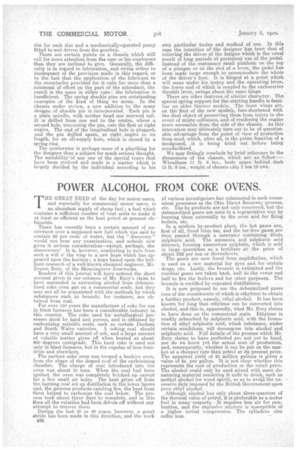POWER ALCOHOL FROM COKE OVENS.
Page 12

If you've noticed an error in this article please click here to report it so we can fix it.
THE GREAT NEED of the day for motor users, and especially for commercial motor users, is an abundant supply of cheap fuel ; a fuel which contains a sufficient number of heat units to make it
at least as efficient as the best petrol at present ob ., fainable. .
' Therehas recently been a certain amount of excitement Over a supposed new fuel which was said to cOntain .95 per cent. of water," but. the " discovery" would not bear any examination, and -nobody now gives it serious consideration—except, perhaps, the discoverers: It is, hoWever, comforting to turn from such a will o' the wisp to a new hope which has appeared upon the horizon ; a hope based upon the brilliant research of a well-known chemical engineer, Mr. Ernest Bury, of the Skinningrove Ironworks.
Readers of -this journal will have noticed the short
account given in our columns of Mr. Bury's claim to , have succeeded in extracting alcohol from ciehenzo:.
lized coke oven gas on a. commercial scale, but they may not all be acquainted with the niethods by which substances such as benzole, for instance, are ob tained from coal. . ,
For_over leo years the manufacture of coke for use in blast furnaces has been .A, considerable industry in. -.this country. The coke used for metallurgical pro; cesses Must be. hard and porous, and is obtained by carbonizing suitable coals, such as certain Durham and South Wales varieties. A coking coal Should have a very small amount of ash, and a large amount of volatile matter given off when heated at about 900 degrees centigrade. This hard coke is used not only in blast. furnaces, but in the cupolas of iron foun
dries and elsewhera. . The earliest coke oven was termed a beehive oven, from the shape of the d.onied roof of the carbonizing chamber. The charge of coal introduced into the oven was about 10 tons. When the coal had been,
ignited, the oven was completely bricked up except for a few small air holes, The heat given off from the burning coal set up distillation in the lower layers and, the gas..e.cius products catching fire, the heat from them helped to carbonize the coal below. The process took about three days tocomplete, and in this time all the volatiles had been driven off without any attempt to recover them.
During the last 30 or 40 years, however, a great stride has been made in this direction, and the work c26 of various investigators has culminated in such economical processes as the Otto Direct Recovery process, etc. The by-products are not only recovered, but the debenzoli'zed gases are used in a regenerative Way by burning them. externally to the oven and for firing boilers, etc. In a modern by-product plant, the hot gases are, first of all, freed from tar, and the tar-free gases are then passed through a saturated. -containing dilute sulphuric acid. The ammonia and sulphuric, acid interact, forming ammonium sulphate, which is sold in large quantities as a fertilizer at-' the price of about £22 per ton or thereabouts. The gases are now freed from naphthaline, winch is used as a raw material for dyes and for certain drugs, etc. Lastly, the benzoie is extracted and the residual gases are taken back, half to ,the 'ovens and half to fire. the boilers and for other purposes. The benzole is rectified .by repeated distillations.
It is now proposed to use debenzolized gases (one of the constituents of which is ethylene) to obtain a further product, namelY, ethyl alcohol. It has been known for long that ethylene can be converted into aleoholaand this is, apparently, what Mr. Bury claims to, have done on the commercial scale. Ethylene is readily arbsorbed by sulphuric acid, with the formation of ethyl sulphuric acid, which substance, under certain conditions, will decompose into alcohol and sulphuric acid. Full details of the process which Mr. Bury claims to have perfected are not yet to hand, nor do we know yet the actual cost. of production, and, consequently, whether it can be put on the Market at a cheaper rate than petrel it its present price. The apparent yield of 23 million 'gallons is given a value of 2s. per gallon. It is not clear "whether this represents the cost of production or the retail price. The alcohol °Mild only be used mixed with some denaturing material rendering it unfit to drink, such as methyl alcohol (or weed spirit), so as to avoid the excessive duty imposed by the British Government upon pure ethyl alcohol.
Although alcohol has only about three-quarters of the tiler:mid Value of petrol, it is preferable as a motor fuel in many respects. It requires less air for combustion, and the explosive mixture is suseeptible of a higher initial compression. The cylinders also suffer less.


























